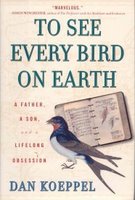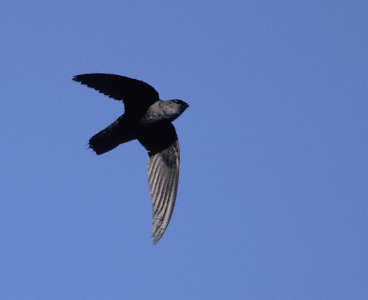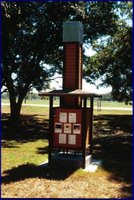Farewell to Arms
12 hours ago
Birding. All the time.
Skin Design:
Free Blogger Skins
 Birders in the mood to buy a T-shirt should check out Jimmy Buffet's Margaritaville website. Mr. Buffett is donating $1 to the National Fish and Wildlife Foundation for the Puerto Rican Parrot Recovery Program for every t-shirt sold. Get your t-shirt and support the critically endangered Puerto Rican Parrot. Seems parrotheads know when to put their money where their mouths are.
Birders in the mood to buy a T-shirt should check out Jimmy Buffet's Margaritaville website. Mr. Buffett is donating $1 to the National Fish and Wildlife Foundation for the Puerto Rican Parrot Recovery Program for every t-shirt sold. Get your t-shirt and support the critically endangered Puerto Rican Parrot. Seems parrotheads know when to put their money where their mouths are.
 For me, black and white usually refers to a species of warbler. But after being profiled on The Cafes User Interface (thanks, I guess) and getting a couple comments from friends about how hard it is to read white text on a black background, I've switched to this black on white format. For now. It looks pretty boring, so I'm in the market for a new look. Feel free to comment or send suggestions on a new template. For now, here's hoping I'm easier to read.
For me, black and white usually refers to a species of warbler. But after being profiled on The Cafes User Interface (thanks, I guess) and getting a couple comments from friends about how hard it is to read white text on a black background, I've switched to this black on white format. For now. It looks pretty boring, so I'm in the market for a new look. Feel free to comment or send suggestions on a new template. For now, here's hoping I'm easier to read.
 Then, I picked up To See Every Bird On Earth by Dan Koeppel, whose father Richard racked up a list of over 7,000 birds in a lifetime of birding and 59 major trips over 17 years before retiring from active birding after some serious health scares. Soon the floodgates were opened, and I found myself dreaming of trips to see exotic birds and wondering about some of the major bird listers that I had heard my friends talk about in the early 90s. Here in Koeppel's book, I got a glimpse of some of these characters--including the legendary Phoebe Snetsinger, who died on a birding trip to Madagascar a few years ago after racking up a still-record-holding list of over 8,500 species, and a current favorite Peter Kaestner, a diplomat for the US state department with a list of over 8,000 birds. (see a list of current global listing standings here)
Then, I picked up To See Every Bird On Earth by Dan Koeppel, whose father Richard racked up a list of over 7,000 birds in a lifetime of birding and 59 major trips over 17 years before retiring from active birding after some serious health scares. Soon the floodgates were opened, and I found myself dreaming of trips to see exotic birds and wondering about some of the major bird listers that I had heard my friends talk about in the early 90s. Here in Koeppel's book, I got a glimpse of some of these characters--including the legendary Phoebe Snetsinger, who died on a birding trip to Madagascar a few years ago after racking up a still-record-holding list of over 8,500 species, and a current favorite Peter Kaestner, a diplomat for the US state department with a list of over 8,000 birds. (see a list of current global listing standings here)  One of the joys I get from living in the city is the chittering calls and aerial acrobatics of the Chimney Swifts that nest on my block. I grew up with Vaux's Swifts in Oregon--birds that usually stay in the coniferous forests, unless they are drawn to urban roosts during migration. Living in the East, Chimney Swifts have been a lot of fun to hang out with, and I look forward to seeing them each year (photo:avesphoto).
One of the joys I get from living in the city is the chittering calls and aerial acrobatics of the Chimney Swifts that nest on my block. I grew up with Vaux's Swifts in Oregon--birds that usually stay in the coniferous forests, unless they are drawn to urban roosts during migration. Living in the East, Chimney Swifts have been a lot of fun to hang out with, and I look forward to seeing them each year (photo:avesphoto). In return for the enjoyment that they bring, there are things that we can actually do to help these amazing birds. My friends Paul and Georgean Kyle in Texas have a Chimney Swift conservation program that they run out of the Driftwood Wildlife Association. They encourage people to build artificial chimneys as roosting and nesting structures for the swifts, and to either clean and manage their chimneys for birds, or to cap them so the birds aren't trapped or tempted to nest in an unsafe chimney. This photo is of a swift tower that also serves as a nature kiosk just off the parking lot of the main building at Hornsby Bend near Austin, Texas. These tower kiosks make perfect mini-nature centers for parks or schools, where they can host info about local birds and nature, as well as serve as a landmark and meeting place for local bird walks or other activities.
In return for the enjoyment that they bring, there are things that we can actually do to help these amazing birds. My friends Paul and Georgean Kyle in Texas have a Chimney Swift conservation program that they run out of the Driftwood Wildlife Association. They encourage people to build artificial chimneys as roosting and nesting structures for the swifts, and to either clean and manage their chimneys for birds, or to cap them so the birds aren't trapped or tempted to nest in an unsafe chimney. This photo is of a swift tower that also serves as a nature kiosk just off the parking lot of the main building at Hornsby Bend near Austin, Texas. These tower kiosks make perfect mini-nature centers for parks or schools, where they can host info about local birds and nature, as well as serve as a landmark and meeting place for local bird walks or other activities. Some of the best info about the birds and what you can do to help them can be found in two Texas A&M Press books recently written by the Kyles. Chimney Swifts covers the biology, life history, and conservation of the birds, while Chimney Swift Towers provides more detailed instructions on how to build artificial structures to attract and help the birds. If you are lucky enough to live in Chimney Swift habitat--and most of us east of the Rockies do, enjoy their aerial chases and courtship flights this month, and take a look to see if there isn't more you can do to encourage "America's mysterious birds above the fireplace".
Some of the best info about the birds and what you can do to help them can be found in two Texas A&M Press books recently written by the Kyles. Chimney Swifts covers the biology, life history, and conservation of the birds, while Chimney Swift Towers provides more detailed instructions on how to build artificial structures to attract and help the birds. If you are lucky enough to live in Chimney Swift habitat--and most of us east of the Rockies do, enjoy their aerial chases and courtship flights this month, and take a look to see if there isn't more you can do to encourage "America's mysterious birds above the fireplace".
 Just before noon, Jim came in to say that he had a Yellow-throated Warbler singing outside his window. We went out and heard it down by the creek. After a few minutes, two of us got quick looks as if flew up onto an exposed branch, before disappearing again. Great to work with birders, and to have migration fever hitting the whole office!
Just before noon, Jim came in to say that he had a Yellow-throated Warbler singing outside his window. We went out and heard it down by the creek. After a few minutes, two of us got quick looks as if flew up onto an exposed branch, before disappearing again. Great to work with birders, and to have migration fever hitting the whole office!
 Took an hour stroll through the woods at work this morning and found 43 species--including nine species of warblers. Nice to see the Indigo Buntings back, as well as to hear Ovenbirds calling from the understory of the woods. Most of the warblers were Yellow-rumped, though I did hear Black-throated Blue, Black-throated Green, and Northern Parula. Wood Thrushes were singing, as was a Hermit Thrush. This time of year, the birds are moving through fast, and different birds are present every day. Its a magical time, so get outside and enjoy the spectacle!
Took an hour stroll through the woods at work this morning and found 43 species--including nine species of warblers. Nice to see the Indigo Buntings back, as well as to hear Ovenbirds calling from the understory of the woods. Most of the warblers were Yellow-rumped, though I did hear Black-throated Blue, Black-throated Green, and Northern Parula. Wood Thrushes were singing, as was a Hermit Thrush. This time of year, the birds are moving through fast, and different birds are present every day. Its a magical time, so get outside and enjoy the spectacle!


